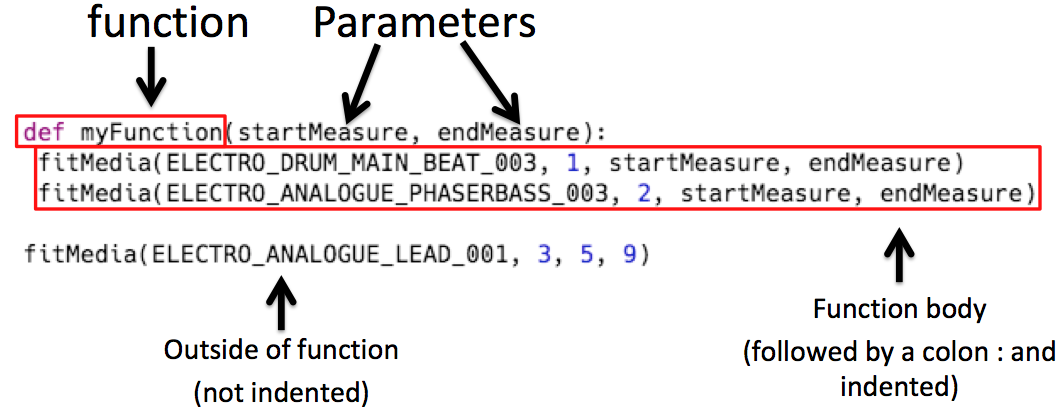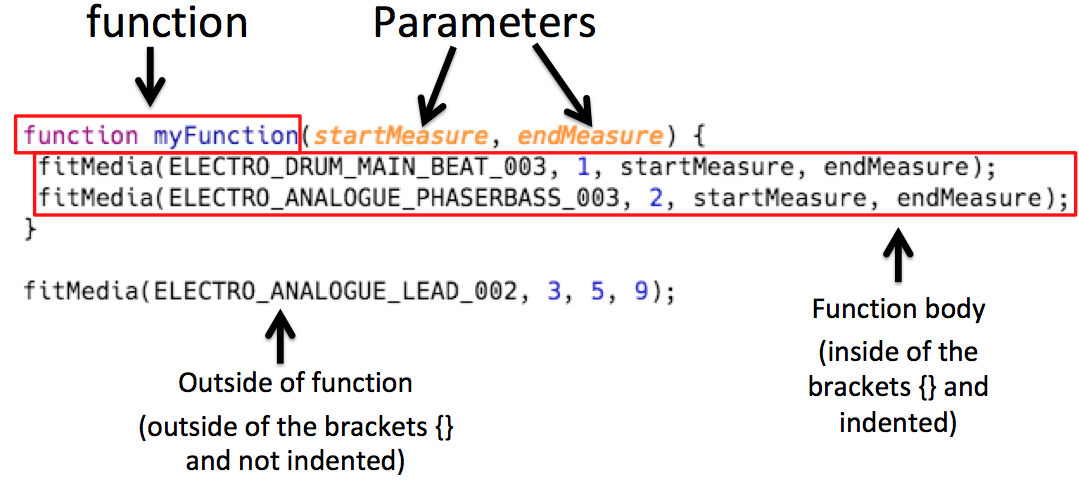Musical Form and Custom Functions
This chapter focuses on coding large-scale changes in music efficiently, which will help you create longer compositions with EarSketch.
Sections and Form
Several measures that express an idea or feeling make up a section. Songs that contain multiple sections allow for variety and structure, or form. Intros, Verses, Choruses, and Outros are examples of sections that contribute to form.
A-B-A Form
The most common form is A-B-A, as it tends to work well musically. The B section adds variety, while returning to the A section invokes familiarity. The code below creates an ABA form:
-
Section A: measures 1-4.
-
Section B: measures 5-8. Features contrasting sounds to Section A.
-
Section A (repeated): measures 9-12.

# A-B-A Form: A song with A and B sections
# Setup
from earsketch import *
setTempo(120)
# Music
# Create an A section
fitMedia(RD_WORLD_PERCUSSION_KALIMBA_PIANO_1, 1, 1, 5) # main
fitMedia(RD_WORLD_PERCUSSION_DRUMPART_24, 2, 1, 5) # drums
fitMedia(RD_WORLD_PERCUSSION_KALIMBA_PIANO_7, 3, 1, 5) # bassline
fitMedia(RD_WORLD_PERCUSSION_KALIMBA_PIANO_3, 4, 1, 2) # backing
fitMedia(RD_WORLD_PERCUSSION_KALIMBA_PIANO_3, 4, 3, 4) # backing repeated
# Create a 4 measure B section between measures 5 and 9
fitMedia(RD_WORLD_PERCUSSION_DRUMPART_3, 1, 5, 9) # sparse drums
fitMedia(RD_WORLD_PERCUSSION_SEEDSRATTLE_1, 3, 5, 9) # rattling
fitMedia(RD_WORLD_PERCUSSION_KALIMBA_PIANO_3, 4, 5, 6) # backing
# Then back to section A at measure 9
fitMedia(RD_WORLD_PERCUSSION_KALIMBA_PIANO_1, 1, 9, 13) # main
fitMedia(RD_WORLD_PERCUSSION_DRUMPART_24, 2, 9, 13) # drums
fitMedia(RD_WORLD_PERCUSSION_KALIMBA_PIANO_7, 3, 9, 13) # bassline
fitMedia(RD_WORLD_PERCUSSION_KALIMBA_PIANO_3, 4, 9, 10) # backing
fitMedia(RD_WORLD_PERCUSSION_KALIMBA_PIANO_3, 4, 11, 12) # backing repeated// A-B-A Form: A song with A and B sections
// Setup
setTempo(120);
// Music
// Create an A section
fitMedia(RD_WORLD_PERCUSSION_KALIMBA_PIANO_1, 1, 1, 5); // main
fitMedia(RD_WORLD_PERCUSSION_DRUMPART_24, 2, 1, 5); // drums
fitMedia(RD_WORLD_PERCUSSION_KALIMBA_PIANO_7, 3, 1, 5); // bassline
fitMedia(RD_WORLD_PERCUSSION_KALIMBA_PIANO_3, 4, 1, 2); // backing
fitMedia(RD_WORLD_PERCUSSION_KALIMBA_PIANO_3, 4, 3, 4); // backing repeated
// Create a 4 measure B section between measures 5 and 9
fitMedia(RD_WORLD_PERCUSSION_DRUMPART_3, 1, 5, 9); // sparse drums
fitMedia(RD_WORLD_PERCUSSION_SEEDSRATTLE_1, 3, 5, 9); // rattling
fitMedia(RD_WORLD_PERCUSSION_KALIMBA_PIANO_3, 4, 5, 6); // backing
// Then back to section A at measure 9
fitMedia(RD_WORLD_PERCUSSION_KALIMBA_PIANO_1, 1, 9, 13); // main
fitMedia(RD_WORLD_PERCUSSION_DRUMPART_24, 2, 9, 13); // drums
fitMedia(RD_WORLD_PERCUSSION_KALIMBA_PIANO_7, 3, 9, 13); // bassline
fitMedia(RD_WORLD_PERCUSSION_KALIMBA_PIANO_3, 4, 9, 10); // backing
fitMedia(RD_WORLD_PERCUSSION_KALIMBA_PIANO_3, 4, 11, 12); // backing repeatedThe sparser sound of the B section above provides contrast. This can usually be a achieved by using fewer instruments or cutting out drum parts. Using different effects, samples, or rhythms can also add contrast.
The above code is large, somewhat messy, and a little confusing. Code is also repeated for the second A section, an indication that the program could be written more efficiently.
Custom Functions
Custom functions allow you to write your own functions and avoid repetitive code. You can give them any name and run them anywhere.
Below, we define and call a function named myFunction(). It has two parameters, meaning it takes two arguments when called. These parameters (startMeasure and endMeasure) hold the arguments being passed to the function, so they can be used inside the function body. A custom function can have as many parameters as necessary.


# Custom Functions: Defining our own function that makes a section of music
# Setup
from earsketch import *
setTempo(100)
# Music
# Defining our new function with two parameters
def myFunction(startMeasure, endMeasure):
fitMedia(ELECTRO_DRUM_MAIN_BEAT_003, 1, startMeasure, endMeasure)
fitMedia(ELECTRO_ANALOGUE_PHASERBASS_003, 2, startMeasure, endMeasure)
# Calling our function, passing it two arguments: 1 and 17.
myFunction(1, 17)// Custom Functions: Defining our own function that makes a section of music
// Setup
setTempo(100);
// Music
// Defining our new function with two parameters
function myFunction(startMeasure, endMeasure) {
fitMedia(ELECTRO_DRUM_MAIN_BEAT_003, 1, startMeasure, endMeasure);
fitMedia(ELECTRO_ANALOGUE_PHASERBASS_003, 2, startMeasure, endMeasure);
}
// Calling our function, passing it two arguments: 1 and 17.
myFunction(1, 17);Let’s apply this new construct to the previous ABA example to make the code more modular. We will make functions for section A and B, and then call them in the order they should appear in the music: ABA
# Improved A-B-A: Creating form with custom functions
# Setup
from earsketch import *
setTempo(120)
# Music
# A section
def sectionA(startMeasure, endMeasure): # create an A section, placing music from startMeasure (inclusive) to endMeasure (exclusive)
fitMedia(RD_WORLD_PERCUSSION_KALIMBA_PIANO_1, 1, startMeasure, endMeasure) # main
fitMedia(RD_WORLD_PERCUSSION_DRUMPART_24, 2, startMeasure, endMeasure) # drums
fitMedia(RD_WORLD_PERCUSSION_KALIMBA_PIANO_7, 3, startMeasure, endMeasure) # bassline
fitMedia(RD_WORLD_PERCUSSION_KALIMBA_PIANO_3, 4, startMeasure, startMeasure + 1) # backing
fitMedia(RD_WORLD_PERCUSSION_KALIMBA_PIANO_3, 4, startMeasure + 2, startMeasure + 3) # backing repeated
# B section
def sectionB(startMeasure, endMeasure):
fitMedia(RD_WORLD_PERCUSSION_DRUMPART_3, 1, startMeasure, endMeasure) # sparse drums
fitMedia(RD_WORLD_PERCUSSION_SEEDSRATTLE_1, 3, startMeasure, endMeasure) # rattling
fitMedia(RD_WORLD_PERCUSSION_KALIMBA_PIANO_3, 4, startMeasure, startMeasure + 1) # backing
# Setting up an ABA musical form through function calls
sectionA(1, 5)
sectionB(5, 9)
sectionA(9, 13)// Improved A-B-A: Creating form with custom functions
// Setup
setTempo(120);
// Music
// A section
function sectionA(startMeasure, endMeasure) { // create an A section, placing music from startMeasure (inclusive) to endMeasure (exclusive)
fitMedia(RD_WORLD_PERCUSSION_KALIMBA_PIANO_1, 1, startMeasure, endMeasure); // main
fitMedia(RD_WORLD_PERCUSSION_DRUMPART_24, 2, startMeasure, endMeasure); // drums
fitMedia(RD_WORLD_PERCUSSION_KALIMBA_PIANO_7, 3, startMeasure, endMeasure); // bassline
fitMedia(RD_WORLD_PERCUSSION_KALIMBA_PIANO_3, 4, startMeasure, startMeasure + 1); // backing
fitMedia(RD_WORLD_PERCUSSION_KALIMBA_PIANO_3, 4, startMeasure + 2, startMeasure + 3); // backing repeated
}
// B section
function sectionB(startMeasure, endMeasure) {
fitMedia(RD_WORLD_PERCUSSION_DRUMPART_3, 1, startMeasure, endMeasure); // sparse drums
fitMedia(RD_WORLD_PERCUSSION_SEEDSRATTLE_1, 3, startMeasure, endMeasure); // rattling
fitMedia(RD_WORLD_PERCUSSION_KALIMBA_PIANO_3, 4, startMeasure, startMeasure + 1); // backing
}
// Setting up an ABA musical form through function calls
sectionA(1, 5);
sectionB(5, 9);
sectionA(9, 13);Now you might be thinking that there isn’t that much of a difference between the examples with function and without function. However, you will notice a difference as you call the function in the code more often. Let’s now try A-B-A-B form. You will notice that the 2nd example, which uses function, is shorter than the 1st example, which does not use function. As you see in the following examples, functions allow you to write an efficient code even as the script becomes more complex.
A-B-A-B form WITHOUT functions
# A-B-A-B Form WITHOUT functions: A song with A and B sections
# Setup
from earsketch import *
setTempo(120)
# Music
# Create an A section
fitMedia(RD_WORLD_PERCUSSION_KALIMBA_PIANO_1, 1, 1, 5) # main
fitMedia(RD_WORLD_PERCUSSION_DRUMPART_24, 2, 1, 5) # drums
fitMedia(RD_WORLD_PERCUSSION_KALIMBA_PIANO_7, 3, 1, 5) # bassline
fitMedia(RD_WORLD_PERCUSSION_KALIMBA_PIANO_3, 4, 1, 2) # backing
fitMedia(RD_WORLD_PERCUSSION_KALIMBA_PIANO_3, 4, 3, 4) # backing repeated
# Create a 4 measure B section between measures 5 and 9
fitMedia(RD_WORLD_PERCUSSION_DRUMPART_3, 1, 5, 9) # sparse drums
fitMedia(RD_WORLD_PERCUSSION_SEEDSRATTLE_1, 3, 5, 9) # rattling
fitMedia(RD_WORLD_PERCUSSION_KALIMBA_PIANO_3, 4, 5, 6) # backing
# Back to section A at measure 9
fitMedia(RD_WORLD_PERCUSSION_KALIMBA_PIANO_1, 1, 9, 13) # main
fitMedia(RD_WORLD_PERCUSSION_DRUMPART_24, 2, 9, 13) # drums
fitMedia(RD_WORLD_PERCUSSION_KALIMBA_PIANO_7, 3, 9, 13) # bassline
fitMedia(RD_WORLD_PERCUSSION_KALIMBA_PIANO_3, 4, 9, 10) # backing
fitMedia(RD_WORLD_PERCUSSION_KALIMBA_PIANO_3, 4, 11, 12) # backing repeated
# Then back to section B at measure 13. The code is starting to look a lot messier when you're not using functions.
fitMedia(RD_WORLD_PERCUSSION_DRUMPART_3, 1, 13, 17) # sparse drums
fitMedia(RD_WORLD_PERCUSSION_SEEDSRATTLE_1, 3, 13, 17) # rattling
fitMedia(RD_WORLD_PERCUSSION_KALIMBA_PIANO_3, 4, 13, 14) # backingA-B-A-B form WITH functions
# A-B-A-B Form WITH functions: Creating form with custom functions
# Setup
from earsketch import *
setTempo(120)
# Music
# A section
def sectionA(startMeasure, endMeasure): # create an A section, placing music from startMeasure (inclusive) to endMeasure (exclusive)
fitMedia(RD_WORLD_PERCUSSION_KALIMBA_PIANO_1, 1, startMeasure, endMeasure) # main
fitMedia(RD_WORLD_PERCUSSION_DRUMPART_24, 2, startMeasure, endMeasure) # drums
fitMedia(RD_WORLD_PERCUSSION_KALIMBA_PIANO_7, 3, startMeasure, endMeasure) # bassline
fitMedia(RD_WORLD_PERCUSSION_KALIMBA_PIANO_3, 4, startMeasure, startMeasure + 1) # backing
fitMedia(RD_WORLD_PERCUSSION_KALIMBA_PIANO_3, 4, startMeasure + 2, startMeasure + 3) # backing repeated
# B section
def sectionB(startMeasure, endMeasure):
fitMedia(RD_WORLD_PERCUSSION_DRUMPART_3, 1, startMeasure, endMeasure) # sparse drums
fitMedia(RD_WORLD_PERCUSSION_SEEDSRATTLE_1, 3, startMeasure, endMeasure) # rattling
fitMedia(RD_WORLD_PERCUSSION_KALIMBA_PIANO_3, 4, startMeasure, startMeasure + 1) # backing
# Setting up an ABA musical form through function calls
sectionA(1, 5)
sectionB(5, 9)
sectionA(9, 13)
sectionB(13, 17) # adding another section B only requires one more line of code if you use a function// A-B-A-B Form WITHOUT functions: A song with A and B sections
// Setup
setTempo(120);
// Music
// Create an A section
fitMedia(RD_WORLD_PERCUSSION_KALIMBA_PIANO_1, 1, 1, 5); // main
fitMedia(RD_WORLD_PERCUSSION_DRUMPART_24, 2, 1, 5); // drums
fitMedia(RD_WORLD_PERCUSSION_KALIMBA_PIANO_7, 3, 1, 5); // bassline
fitMedia(RD_WORLD_PERCUSSION_KALIMBA_PIANO_3, 4, 1, 2); // backing
fitMedia(RD_WORLD_PERCUSSION_KALIMBA_PIANO_3, 4, 3, 4); // backing repeated
// Create a 4 measure B section between measures 5 and 9
fitMedia(RD_WORLD_PERCUSSION_DRUMPART_3, 1, 5, 9); // sparse drums
fitMedia(RD_WORLD_PERCUSSION_SEEDSRATTLE_1, 3, 5, 9); // rattling
fitMedia(RD_WORLD_PERCUSSION_KALIMBA_PIANO_3, 4, 5, 6); // backing
// Back to section A at measure 9
fitMedia(RD_WORLD_PERCUSSION_KALIMBA_PIANO_1, 1, 9, 13); // main
fitMedia(RD_WORLD_PERCUSSION_DRUMPART_24, 2, 9, 13); // drums
fitMedia(RD_WORLD_PERCUSSION_KALIMBA_PIANO_7, 3, 9, 13); // bassline
fitMedia(RD_WORLD_PERCUSSION_KALIMBA_PIANO_3, 4, 9, 10); // backing
fitMedia(RD_WORLD_PERCUSSION_KALIMBA_PIANO_3, 4, 11, 12); // backing repeated
// Then back to section B at measure 13. The code is starting to look a lot messier when you're not using functions.
fitMedia(RD_WORLD_PERCUSSION_DRUMPART_3, 1, 13, 17); // sparse drums
fitMedia(RD_WORLD_PERCUSSION_SEEDSRATTLE_1, 3, 13, 17); // rattling
fitMedia(RD_WORLD_PERCUSSION_KALIMBA_PIANO_3, 4, 13, 14); // backing// A-B-A-B Form WITH functions: Creating form with custom functions
// Setup
setTempo(120);
// Music
// A section
function sectionA(startMeasure, endMeasure) { // create an A section, placing music from startMeasure (inclusive) to endMeasure (exclusive)
fitMedia(RD_WORLD_PERCUSSION_KALIMBA_PIANO_1, 1, startMeasure, endMeasure); // main
fitMedia(RD_WORLD_PERCUSSION_DRUMPART_24, 2, startMeasure, endMeasure); // drums
fitMedia(RD_WORLD_PERCUSSION_KALIMBA_PIANO_7, 3, startMeasure, endMeasure); // bassline
fitMedia(RD_WORLD_PERCUSSION_KALIMBA_PIANO_3, 4, startMeasure, startMeasure + 1); // backing
fitMedia(RD_WORLD_PERCUSSION_KALIMBA_PIANO_3, 4, startMeasure + 2, startMeasure + 3); // backing repeated
}
// B section
function sectionB(startMeasure, endMeasure) {
fitMedia(RD_WORLD_PERCUSSION_DRUMPART_3, 1, startMeasure, endMeasure); // sparse drums
fitMedia(RD_WORLD_PERCUSSION_SEEDSRATTLE_1, 3, startMeasure, endMeasure); // rattling
fitMedia(RD_WORLD_PERCUSSION_KALIMBA_PIANO_3, 4, startMeasure, startMeasure + 1); // backing
}
// Setting up an ABAB musical form through function calls
sectionA(1, 5);
sectionB(5, 9);
sectionA(9, 13);
sectionB(13, 17); // adding the B section only requires one more line of code if you use a functionCustom functions can be called in any order, allowing us to play with form. Using different parameters for each function call enables more complex forms, an improvement over simple repetition.
Abstraction
In programming we can create abstractions, just as we group musical ideas into sections. An abstraction is a bundling of ideas to form a single concept. Functions are one kind of abstraction used in computer science. They pack multiple statements into one tool so they can be easily referred to. They also help manage the complexity of a program; the user doesn’t have to worry about what is in the function body. Abstractions can make the form of a program more clear, which is helpful when writing and debugging large programs.
Chapter 9 Summary
-
Sections are related musical units consisting of multiple measures. Each expresses an idea or feeling.
-
The structure and variety found within a song is known as its form. The most common musical form is A-B-A.
-
Custom functions are unique functions written by the programmer to accomplish a specific task. Custom functions are an effective way to code sections, helping to avoid repetitive code. They are named by the programmer and can be called anywhere in a script.
-
An abstraction is the bundling of ideas to form a single, often less complex, concept. Functions are an example of abstraction.
Questions
Which of these is NOT an example of a musical section?
-
Drums
-
Intro
-
Verse
-
Chorus
What is an abstraction?
-
A bundling of ideas to form a single concept
-
A variety of sounds throughout sections
-
Parts of a song that are related, but also are distinct from each other
-
A statement that returns a value to the function call
Which of these options correctly defines the function myFunction() with the parameters, startMeasure and endMeasure?
-
def myFunction(startMeasure, endMeasure): -
def myFunction(): -
myFunction(startMeasure, endMeasure): -
myFunction(2, 5)
Which of these options correctly defines the function myFunction() with the parameters startMeasure and endMeasure ?
-
function myFunction(startMeasure, endMeasure) {} -
function myFunction() {} -
myFunction(startMeasure, endMeasure){} -
myFunction(2, 5)